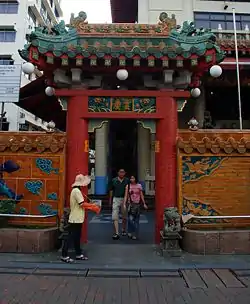Kwan Im Thong Hood Cho Temple
Kwan Im Thong Hood Cho Temple (Chinese: 觀音堂佛祖廟; pinyin: Guānyīn Táng Fózǔ Miào) is a traditional Chinese temple situated at 178 Waterloo Street in Singapore. The temple is of significance to the Chinese in Singapore, and is believed to bring worshippers good luck after praying to the Kuan Yin (觀世音菩薩), or Avalokiteśvara, the Goddess of Mercy. The temple is also involved in charity work, contributing to several health and educational organisations.[1]
觀音堂佛祖廟 | |
 The exterior of Kwan Im Thong Hood Cho Temple | |
| Monastery information | |
|---|---|
| Full name | Kwan Im Thong Hood Cho Temple |
| Order | Mahayana, Vajrayana |
| Established | 1884 |
| Site | |
| Location | Rochor, Singapore |
| Public access | yes |
| Part of a series on |
| Buddhism |
|---|
 |
|
The Kwan Im Temple and the nearby Sri Krishnan Temple are known for having evolved a social practice termed "cross-worshipping", where many devotees of either temple also worship at the other. This practice is commonly seen as a microcosm of Singapore's multi-religious society.[2][3][4]
History and architecture

The temple has existed since 1884 at its present location with a reconstruction in 1895. The original temple was an example of Chinese temple architecture and traditional craftsmanship. In its vicinity were other places of worship such as the adjacent Sri Krishnan Temple, Church of Saints Peter and Paul at Queen Street, Maghain Aboth Synagogue and the Malabar Jama-ath Mosque. The original temple, entry was gained across a large sheltered courtyard through a porch and screened anteroom. The main hall then contained three altars, the central one for the Kuan Yin and one each for Bodhidharma (the founder of Zen Buddhism) and Hua Tuo, a Chinese patron saint of medicine and healing on the flanking altars. An image of Sakyamuni Buddha was kept in the rear hall and various ancillary rooms on either side. During the second World War, the temple was spared of destruction when all the other buildings in the area were severely damaged. It provided refuge for the sick, the wounded and the homeless.[5]
In 1982, the temple was extensively rebuilt as it needed to increase its capacity due to the high number of worshipers at the temple. All deities were enshrined on a single altar in the prayer hall with the elevated statue of Sakyamuni Buddha placed behind Kuan Yin. The relative positions of other deities remain unchanged. A large space of two separate roofs of different height. The entrance wall is a large central gateway flanked by two smaller ones and colours are rich in golden yellows, reds, blues and greens. At the ends of all the roof rafters, there are yellow Buddhist swastikas on a green ground. The roof decorations are comparatively constrained, the ridges, having simple curves with decorations of good omen. The tiles inside the hall of the temple are currently being changed from ceramics to granite. Candles and incense are not burnt inside the temple hall, but burnt in an urn at the entrance of the temple to prevent the soot from staining the ceiling.[6]
Singapore Biennale
During the inaugural Singapore Biennale in 2006, it was used as a site to display artworks of several artists. A carpet designed by Xu Bing, a lotus mantra by Tsai Charwei, 1001 Buddha statues by Hiroshi Sugimoto and a "Please Love Me" sign written in the four official languages of Singapore by Santiago Cucullu.[1]
Worship

Kwan Im Temple remains as one of the major temples in the area, with thousands of devotees visiting the temple to pray for blessings from Kwan Yin. Devotees believe that they will be blessed after worshiping at the temple, thus making it one of the most visited temples in Singapore. Devotees are known to visit the temple on the first or fifteenth day of Chinese New Year seeking blessings. On the eve of Chinese New Year, the temple is opened all night and the street is often packed with devotees queuing shoulder to shoulder to enter the temple hall to offer their incense to the Kwan Yin in hope for an auspicious start to the New Year. The temple is well known for its divination activities which are believed to be very accurate.
Over time, a practice of "cross-worshipping" has evolved between devotees of the Sri Krishnan Temple and the Kwan Im Thong Hood Cho Temple, where many devotees of either temple also worship at the other.[2] Both temples are affiliated with polytheistic religions: Hinduism and the Chinese folk religion, and this practice is commonly seen as a microcosm of Singapore's multi-religious society. In the late 1980s, a seller of Hainanese chicken rice donated a large urn, worth approximately S$1,000, to the Sri Krishnan Temple, to hold the joss sticks of Chinese worshippers. The Sri Krishnan temple administration has added a statue of Guanyin inside their temple and designated a zone within the temple compound for Chinese worshippers to burn joss sticks.[7][8]
Charity work
The temple is known for its work towards charity since 1997. It first set up a Kidney Dialysis Centre at Simei, setting up an educational bursary and providing treatment to anybody regardless of race. Also, it embarked a national health screening programme, and set up a professorship in computing at the National University of Singapore in 2000 by donating S$1.5 million. The temple also donated to the National Kidney Foundation Singapore and is a patron of the Singapore arts scene.[5][6]
References
- "Singapore: Kwan Im Thong Hood Cho Temple". Retrieved 22 May 2007.
- Mah, James (5 December 2019). "Sri Krishnan Temple: Doing and Making Sense of a Shared Multi-sensorial, Multi-religious Space in Singapore". The Jugaad Project. Retrieved 24 November 2020.
“Same, same lah!” an elderly Chinese lady remarked in Mandarin after I asked why she would pray at both the Sri Krishnan Temple and the Kwan Im Thong Hood Cho Temple along Waterloo Street. Her comment disarmed me because it offered such a succinct explanation for the much vaunted religious diversity of the place. In one fell swoop, the lady married two religious realms, which would typically have been construed by outsiders as separate and distinct.
- "In historic Kampong Bencoolen, a thriving league of faiths". TODAYonline. Retrieved 24 November 2020.
A walk along the historic Kampong Bencoolen area is a journey across faiths, living proof of Singapore’s multiracial, multi-cultural, multi-religious society.
- Wee, Cheryl Faith (15 August 2014). "Religious melting pot in Waterloo St". The Straits Times. Retrieved 24 November 2020.
"The area in Waterloo Street epitomises the multi-religious aspect of Singapore," said local urban historian Lai Chee Kien.
- "Kwan Im Thong Hood Cho Temple". Archived from the original on 19 March 2007. Retrieved 1 June 2007.
- Thulaja, Naidu Ratnala. "Kwan Im Thong Hood Cho Temple – Singapore Infopedia". National Library Board. Archived from the original on 4 July 2007. Retrieved 1 June 2007.
- Wee, Cheryl Faith (15 August 2014). "Religious melting pot in Waterloo St". The Straits Times. Retrieved 24 November 2020.
But devotees of one temple spill over to the other; the area overflows with fortune tellers, sellers of fresh chrysanthemum and lotus flowers, and cheerful refrains of "Miss, do you want to buy flowers?"
- "Sri Krishnan Temple | Singapore Attractions". Lonely Planet. Retrieved 24 November 2020.
Pragmatic worshippers from the neighbouring Buddhist Kwan Im Thong Hood Cho Temple also burn joss sticks here for extra insurance.
Further reading
- National Heritage Board (2002). Singapore's 100 Historic Places. Eastern University Press. ISBN 981-4068-23-3.
- Edwards, Norman; Keys, Peter (1988). Singapore: A Guide to Buildings, Streets, Places. Times Books International. ISBN 978-9971-65-231-9.
External links
| Wikimedia Commons has media related to Kwan Im Thong Hood Cho Temple. |